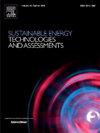通过可再生能源工艺实现可持续制氢的障碍及其对环境的影响
IF 7.1
2区 工程技术
Q1 ENERGY & FUELS
Sustainable Energy Technologies and Assessments
Pub Date : 2024-11-05
DOI:10.1016/j.seta.2024.104075
引用次数: 0
摘要
不可再生的氢气(H2)生产资源是造成空气污染、酸雨和温室气体排放的主要因素,加剧了环境退化。因此,将可再生能源与制氢技术相结合至关重要,因为我们迫切需要减少碳足迹、采用更清洁的能源替代品,并加快向可持续的生态友好型未来过渡。太阳能已成为一种前景广阔的 H2 生产能源。此外,风能和地热能资源也被用于生产 H2。这些可再生资源对环境友好,成本效益高,在减少碳排放方面发挥了重要作用。这些系统具有可扩展性和多功能性,可满足不同的 H2 生产需求。然而,间歇性、低能量密度和高初始成本是高效生产 H2 需要解决的基本限制。本文对可再生能源技术,特别是各种燃料电池、太阳能、风能和地热对环境的影响进行了深入分析。它评估了生态足迹,强调了每种技术的优势和潜在缺点。比较研究不仅要强调这些可再生能源的环境效益,还要应对它们带来的挑战,重点是提高其可持续性。本综述论文还深入探讨了通过可再生技术生产 H2 所面临的问题和挑战。本文章由计算机程序翻译,如有差异,请以英文原文为准。
Barriers to sustainable hydrogen production through renewable energy processes and their environmental impacts
Non-renewable resources of hydrogen (H2) production are major contributors to air pollution, acid rain, and greenhouse gas emissions, exacerbating environmental degradation. Therefore, the integration of renewable energy sources with of H2 technologies is crucial due to the pressing need to reduce carbon footprints, embrace cleaner energy alternatives, and accelerate the transition towards a sustainable, eco-friendly future. Solar energy has emerged as a promising source for H2 production. In addition, wind and geothermal energy resources have also been used to produce H2. These renewable resources are environmentally friendly, and cost-effective options have played a vital role in reducing carbon emissions. These systems are scalable and versatile, catering to varying demands for H2 production. However, intermittency, low energy density, and high initial costs are fundamental limitations that need to be addressed for efficient H2 production. This paper provides an insightful analysis of the environmental impacts of renewable energy technologies, specifically various fuel cells, solar, wind energy, and geothermal. It assesses the ecological footprints, highlighting the advantages and potential drawbacks associated with each technology. The comparative study seeks to not only underscore the environmental benefits of these renewables but also to address the challenges they pose, with a focus on enhancing their sustainability profile. This review paper also provides an insightful issues and challenges of H2 production through renewable technologies.
求助全文
通过发布文献求助,成功后即可免费获取论文全文。
去求助
来源期刊

Sustainable Energy Technologies and Assessments
Energy-Renewable Energy, Sustainability and the Environment
CiteScore
12.70
自引率
12.50%
发文量
1091
期刊介绍:
Encouraging a transition to a sustainable energy future is imperative for our world. Technologies that enable this shift in various sectors like transportation, heating, and power systems are of utmost importance. Sustainable Energy Technologies and Assessments welcomes papers focusing on a range of aspects and levels of technological advancements in energy generation and utilization. The aim is to reduce the negative environmental impact associated with energy production and consumption, spanning from laboratory experiments to real-world applications in the commercial sector.
 求助内容:
求助内容: 应助结果提醒方式:
应助结果提醒方式:


